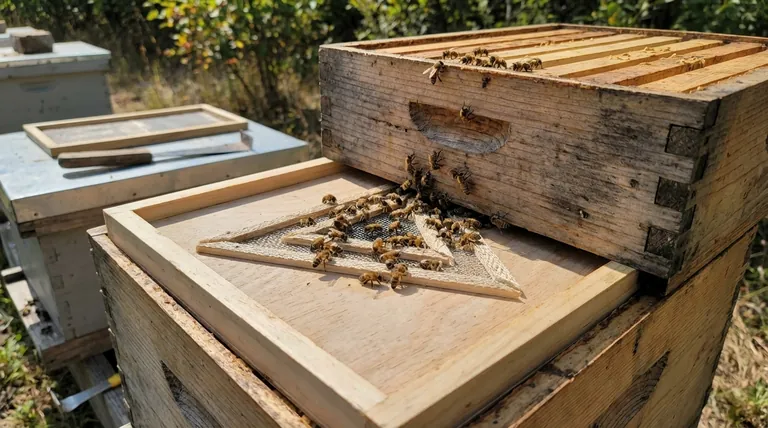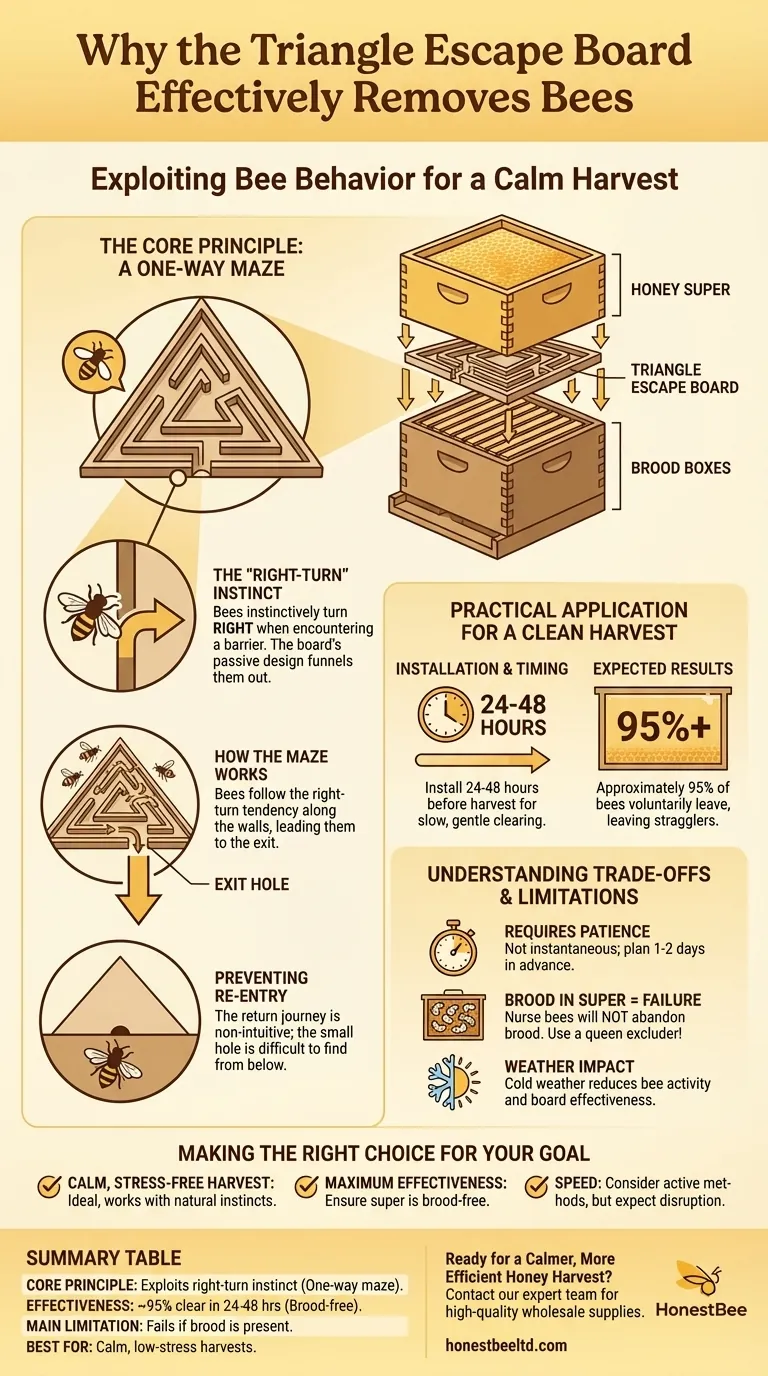At its core, the Triangle Escape Board works by exploiting a simple, predictable bee behavior. When a walking bee encounters a barrier, it has a strong tendency to turn right. The board's design is a passive, one-way maze that uses this instinct to funnel bees out of the honey super and prevent them from finding their way back in.
The key to the Triangle Escape Board's success is that it doesn't repel or force bees out. Instead, it provides a simple, voluntary exit route that is intentionally difficult to navigate in reverse, leading to a calm and nearly complete clearing of the honey super.

The Core Principle: A One-Way Maze
The entire function of the board relies on understanding how bees navigate tight spaces on foot. It’s less about intelligence and more about instinct.
The "Right-Turn" Instinct
When a honeybee is walking along a surface and its path is blocked, its instinct is to turn right to navigate around the obstacle. This is a consistent and predictable behavior that beekeepers can use to their advantage.
How the Maze Works
The Triangle Escape Board is placed between the honey super to be harvested and the brood boxes below. Bees looking to move down to the main hive enter the triangular "mazes." As they walk along the inside walls of the triangles, their right-turn tendency naturally guides them toward the small exit holes leading down into the brood box.
Preventing Re-entry
The design makes the return journey non-intuitive. If a bee from the brood box tries to re-enter the super from below, it encounters the solid, wide base of the triangle. The small exit hole it just passed through is now difficult to locate. The bee's instinct to walk along the surface doesn't easily lead it back to the tiny opening.
Practical Application for a Clean Harvest
Using the board correctly is simple, but timing and placement are crucial for the best results.
Installation and Timing
The board should be installed 24 to 48 hours before you plan to harvest. This gives the bees ample time to move down into the main part of the hive at their own pace.
Expected Results
A properly installed board will get approximately 95% of the bees out of the honey super. It is normal for a few stragglers to remain, but the frames will be clear enough for a clean and easy harvest.
Understanding the Trade-offs and Limitations
While highly effective, the Triangle Escape Board is not a perfect solution for every situation. Understanding its limitations is key to using it successfully.
It Requires Patience
This method is not instantaneous. It requires planning your harvest at least one to two days in advance. It is a passive tool designed for a slow, gentle clearing of the bees.
Brood in the Super Will Cause Failure
This is the most common reason for an escape board not working. Nurse bees will not abandon brood (eggs, larvae, or pupae). If you have brood in your honey supers, the bees will stay to care for it, and the board will be ineffective. Using a queen excluder earlier in the season is the best way to prevent this.
Weather Can Impact Effectiveness
In cold weather, bees are less active and more likely to be clustered together for warmth. They may not move down through the escape board as readily, reducing its effectiveness.
Making the Right Choice for Your Goal
To decide if this tool is right for you, consider your primary objective.
- If your primary focus is a calm, stress-free harvest: The Triangle Escape Board is the ideal tool, as it works slowly and passively with the bees' natural instincts.
- If your primary focus is maximum effectiveness: Always ensure your honey supers are free of brood before installing the board, as this is the single most important factor for success.
- If your primary focus is speed: You may need to consider a more active removal method, but be aware that these can be more disruptive and stressful for the colony.
By working with your bees' natural behavior instead of against it, you can achieve a peaceful and efficient honey harvest.
Summary Table:
| Key Factor | Description | Expected Outcome |
|---|---|---|
| Core Principle | Exploits bees' instinct to turn right when walking, creating a one-way maze. | Natural, voluntary bee exit from the super. |
| Effectiveness | Properly installed on a brood-free super 24-48 hours before harvest. | Clears approximately 95% of bees from the super. |
| Main Limitation | Will not work if brood (eggs, larvae) is present in the honey super. | Nurse bees will not abandon brood. |
| Best For | Beekeepers seeking a calm, low-stress harvest method that works with bee instincts. | A peaceful and efficient harvest. |
Ready for a Calmer, More Efficient Honey Harvest?
HONESTBEE supplies high-quality beekeeping supplies and equipment, including reliable escape boards, to commercial apiaries and beekeeping equipment distributors through our wholesale-focused operations. Let us help you equip your operation for success.
Contact our expert team today to discuss your needs and discover how our products can benefit your business!
Visual Guide

Related Products
- HONESTBEE Wooden Bee Escape Board with Triangle Mesh Design for Beekeeping
- Circular Labyrinth Bee Escape for Efficient Hive Management
- High-Efficiency Diamond Maze Bee Escape for Clearing Supers
- HONESTBEE Multi Exit Plastic Bee Escape Board for Efficient Honey Harvesting
- Professional Durable Two-Piece Plastic Bee Escape
People Also Ask
- What types of bee escape boards are available? Clear Your Supers Fast and Stress-Free
- Where should the triangle escape board be placed in the hive? Master a Gentle, Stress-Free Honey Harvest
- What is the recommended time to leave the triangle escape board installed before harvesting honey? A Guide to a Stress-Free Harvest
- What precautions should be taken when using the triangle escape board? Master Gentle Honey Harvesting
- What is the effectiveness of the Bee Escape Board? Achieve a Calm, 95% Bee-Free Honey Harvest



















